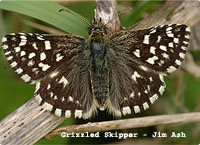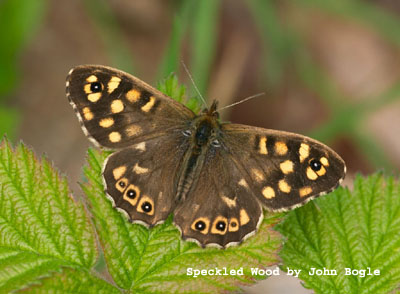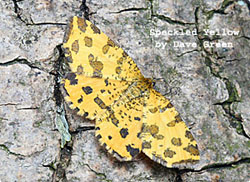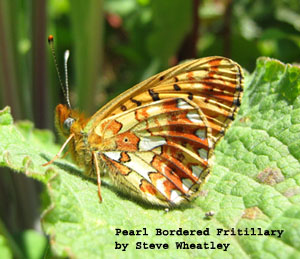Woodland Butterflies

With Spring approaching butterflies are starting appear once more. Peacocks and Comma butterflies, which overwinter as adults (wings closed to blend in with wood and old leaves), can be seen on Spring days. The fast and purposeful Comma often aggressively patrols clearings at about head height, often returning to the same location every few minutes. If you startle one, just take a step back and wait quietly for it to return.
In late April and early May the true woodland specialist butterflies start to emerge, captalising on the Spring ground-flora which flowers before the shady woodland canopy fully develops. Grizzled Skipper, Wood White, and Peal-bordered Fritillary are true woodland specialists but have disappeared from many of our woods due to a decline in traditional woodland management practices such as coppicing. If you find them in your wood you are very lucky indeed and are likely to be in possession of a wood or in a landscape that has enjoyed a long continuity of sensitive management.
Woods in which there has been a break or change in management might have lost these beautiful woodland specialist butterflies. A common indicator of this is the presence of the Speckled Yellow moth, which can often be found in woods where bramble and other woody shrubs have invaded formerly open glades or rides. This lovely light yellow moth is sometimes mistaken for a Pearl-bordered Fritillary but is lighter and flies with a jagged side-to-side flight at about chest height, whereas the Pearl-bordered Fritillary is more orange and flies at knee height.
 In grassier areas (often a sign of regular cutting or grazing) springtime Orange-tips can be found whilst big, bright yellow Brimstones can be found where there is a nearby source of Alder Buckthorn. The Speckled Wood (one of my very favourites) is another indicator of a closing canopy. Its rich brown wings with yellow dapples exactly match its preferred habitat of lightly shaded woodland with dappled light.
In grassier areas (often a sign of regular cutting or grazing) springtime Orange-tips can be found whilst big, bright yellow Brimstones can be found where there is a nearby source of Alder Buckthorn. The Speckled Wood (one of my very favourites) is another indicator of a closing canopy. Its rich brown wings with yellow dapples exactly match its preferred habitat of lightly shaded woodland with dappled light.
In June the woodland butterflies are relatively quiet but you can still see more ubiquitous species such as the ‘Cabbage’ Whites and Red Admirals. Ringlets also emerge at this time. They like scrubby edges with lots of bramble and can often be found in sunny areas where woodlands adjoin open fields. If you have particularly sharp eyes or are very lucky you might spot a Green Hairstreak (our only green butterfly).
In July the kings of woodland butterflies emerge: the White Admiral and the Silver-Washed Fritillary. These are large, strong flyers that can tolerate shaded woodlands. The bright orange Silver-Washed Fritillary can be found holding territory in sunny glades or on woodland rides and but the females are happy to head into the dark woodland to for egg laying. The White Admiral is just as happy on narrower woodland paths and high on the trunks on the edges of clearings. The Purple Emperor is perhaps the most stunning of the woodland butterflies. The iridescent blue males patrol high in the canopy of mature stands of ‘master’ trees: oaks and sallows. Rarely seen but difficult to mistake, with their strong gliding flight, they are a true jewel for any woodland owner.
By August the woodland canopy is fully developed and the birds are starting to fatten up for winter – not such a good time to be a woodland butterfly or juicy caterpillar. This is a good time to look for moths. Put a bright light near a white sheet and see what comes along. Alternatively paint a mixture of red wine, brown sugar and black treacle on a tree over a series of nights and use a torch to check for insect visitors. It’s definitely a good excuse to take a bottle of red wine into the woods for the evening!
 Almost all of the woodland specialist butterflies above are declining in abundance or distribution, as are two-thirds of all butterfly species. The Pearl-bordered Fritillary and Wood White are now almost extinct in the South East due to changes in the structure of woodlands and the decline of traditional woodland management. Therefore, it is crucially important that, where woodland butterflies are seen, they are recorded and their habitats are conserved through careful and deliberate woodland conservation. It is also important that we enjoy them when we see them. Their presence or absence can tell us a lot about our woodlands.
Almost all of the woodland specialist butterflies above are declining in abundance or distribution, as are two-thirds of all butterfly species. The Pearl-bordered Fritillary and Wood White are now almost extinct in the South East due to changes in the structure of woodlands and the decline of traditional woodland management. Therefore, it is crucially important that, where woodland butterflies are seen, they are recorded and their habitats are conserved through careful and deliberate woodland conservation. It is also important that we enjoy them when we see them. Their presence or absence can tell us a lot about our woodlands.
Steve Wheatley is Butterfly Conservation's Project Officer at Rother Woods, East Sussex. You can see more of Butterfly Conservation's work at their website http://www.butterfly-conservation.org/ .
Comments are closed for this post.
Discussion
Most butterflies enjoyed a good spring, especially in April and May, with really good numbers of common species like Orange Tip and Brimstone, which also enjoyed a longer flight period than normal as we had several weeks of sustained hot weather. However, woodlands in early spring can actually be fairly quiet for butterflies if you don’t have any of the rarer species like Pearl-bordered Fritillary (only 1 site left in West Sussex now!). There is then a bit of a gap at the beginning of June, but you should now see butterfly numbers build up again if the weather is good. Common species like Large Skipper (small and orange and fast-flying) and Ringlet (beautiful chocolate brown with a series of eye-spots)are now starting to emerge, with Meadow Brown and Gatekeeper (confusingly similar!) also on the wing. The real stars of high summer woods are alos just starting to be seen – the large bright orange Silver-washed Fritillary and elegant pied White Admiral will both be flitting down wide rides on sunny days. Your best chance of seeing them well is to hang aorund a sunny bramble patch. Purple Hairstreaks will be in the oak canopy (small and silvery grey unless you get a good view) and West Sussex is also a good spot for the elusive Purple Emperor, which you might see sailing through the canopy or, if you’re really lucky, down on the ground. Take a look at the sussex butterflies website for more tips and daily sightings http://www.sussex-butterflies.org.uk/
We have 40 acres of West Sussex woodland that we have worked very hard on over the past three years which was untouched since the 87 storm , opening up the rides, put in a pond , working with the FC on biodiversity grants. We noticed a real increase of butterflies last year and insects in general, however far fewer this year except for a profusion of weird black winged creatures 6 weeks ago- r we’ve still been clearing …has the weather affected them at all? We thought the warmer weather would have been ideal? any answers?
At the end of July (2010), there is the BIG BUTTERFLY COUNT – see
http://www.bigbutterflycount.org/
[…] also the post on woodland butterflies : http://www.woodlands.co.uk/blog/wildlife/woodland-butterflies/AKPC_IDS += […]
formidable site this http://www.woodlands.co.uk rated to see you have what I am actually looking for here and this this post is exactly what I am interested in. I shall be pleased to become a regular visitor :)
We have coppiced up a ride this year, with some advice from Steve, and we are already seeing butterflies much further into the woods with the new light. You can read more about it on our blog: http://peplers.blogspot.com/2009/04/our-wildlife-corridor-is-working.html
Steve has some woodland walks planned, one of them in our wood. Let me know if you would like to come along, 3rd May. Email me if you are interested to look at butterfly ID and habitats.
[email protected]
Watching for butterflies has certainly added to the enjoyment of our wood,so thanks to Steve for pointing us in the right direction. The warm sunshine on our newly coppiced area this month produced more Peacock butterlies than we could count and several Commas. Looking forward to what else may be encouraged in as the year progresses.

[…] S. (2009) Woodland Butterflies. Available at: http://www.woodlands.co.uk/blog/flora-and-fauna/woodland-butterflies/ (Accessed: 29 March […]
Bringing on the Butterflies | Notes From The Wild
30 March, 2016